Early last month I made my second trip to Hampi with the goal of actually exploring the city this time. My 1st trip was focused primarily on Wine tasting as there are some pretty cool Vineyards around Hampi. I am going to break this writeup into two parts, in the first part I am going to talk about all the regular Hampi monuments that everyone explores. In Part 2 I am going to talk about a historic site that hardly anyone knows about which is about 3000-4000 years old approximately and is similar to Stonehenge. (More details in the next post 🙂 )
Hampi is one of the lesser known historic sites in India and it is better known in the south than in the north. It’s name is derived from Pampa which is another name of the goddess Parvati. I first heard about it when I moved to Bangalore in 2010. It was a popular destination with a certain group of people because of the Hippie island and the easy availability of drugs etc. With the administration looking for better crowd of travelers and less drugs etc along with the desire to remove the encroachment into forest lands, the island was cleared, and a lot of work is being done to restore/maintain the historical monuments.
First Day
Our trip started on 6th July, just after the Evolve Back, Hampi resort reopened their doors to visitors when the Karnataka lockdown rules were eased. We had originally planned to travel on the 29th June but due to the lockdown had to push the trip out by a week. As always, we started early in the morning around 6:30am so as to avoid the Bangalore traffic which has been slowly going back to the pre-lockdown levels. The drive to Hampi was fantastic and the roads are amazing. I had to consciously remind myself to slow down as it was quite easy to go super-fast without realizing it. The highway system in India has really improved in the last few years. We reached the Evolve Back campus without any issues except for a minor funny incident right at the end. When we were less than 1 km from the resort, our GPS told us to turn into a complex which it claimed was the resort, but it turned out to be the Forest Department’s office. When we asked them where the resort was, they looked at us like we were crazy, and the guy told us “This is not the resort”. When we told them that we knew this wasn’t the resort and asked for directions they told us to drive on for another 600-800mtrs and the resort was there on the left side. I think that the issue happened due to the GPS losing satellite signal and thus lost an accurate reading of where we were. In any case we reached the venue and checked in without any further confusion.
This was our third stay at the Evolve Back properties, and I have to say that they outdid themselves with the service they provided. This is from the check-in staff to the waiters, manager, trail guides to everyone. To give an idea of the service level and the personalized service we got here are a few small examples. Jani always takes hot water when we go out and I take ice-cold water, we told the serving staff this during our first meal there. After that they ensured we got a glass of hot water and a glass of cold water every single time without asking. They also remembered that we both liked our food to be spicy so all our meals were custom made to be spicier than the usual. In fact the chef actually came and chatted with us multiple times to ensure that the food was made as per our requirements. Even the room we were allocated was selected to give us great views of the sunrise (which we missed because we were sleeping) and the sunset (which we missed because we were on the trails). But it is the thought that counts. Every single person there was always smiling and working to ensure we had a great visit. I am bad with remembering names and since Jani already did a post detailing our stay and how all of the staff made this a fantastic stay, I am not going to duplicate the work here. You can read her writeup of our trip here, on her blog.
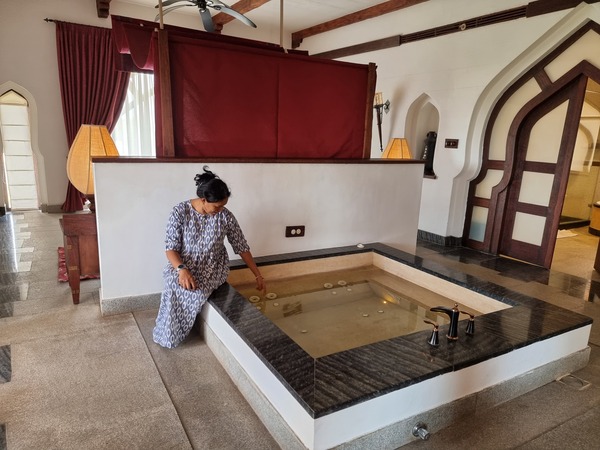
The Room we stayed in at Evolve Back, Hampi
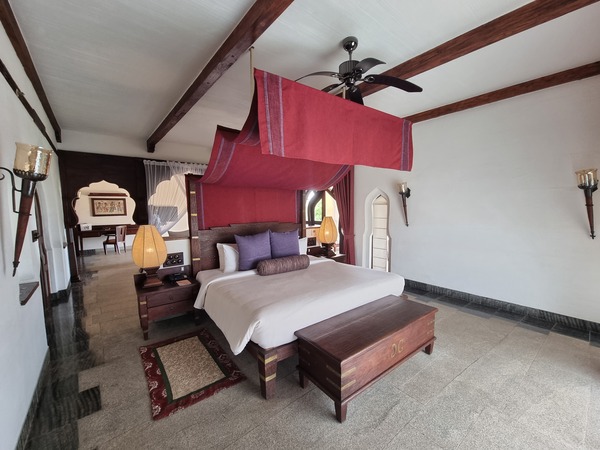
The Room we stayed in at Evolve Back, Hampi
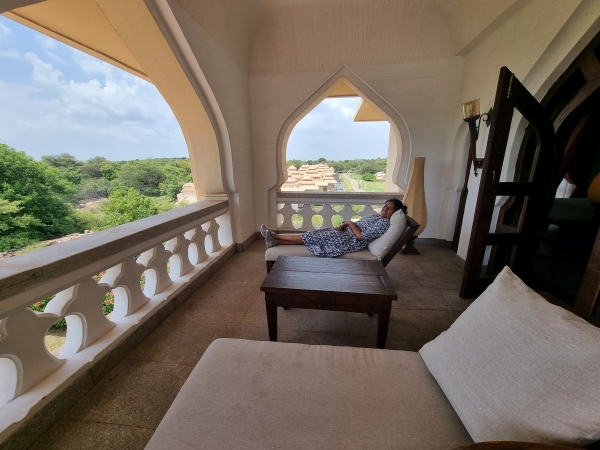
View from the Balcony
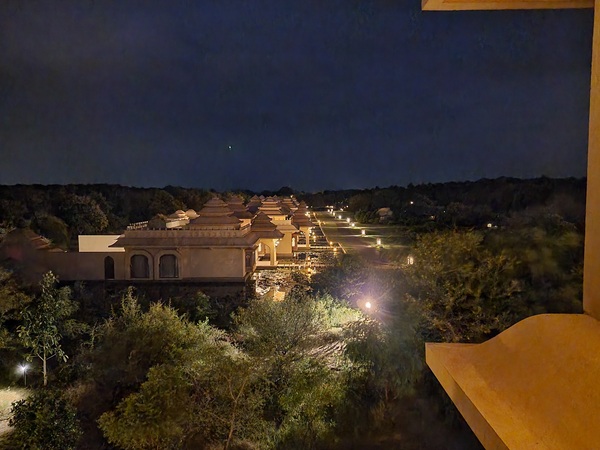
Night View from our Balcony
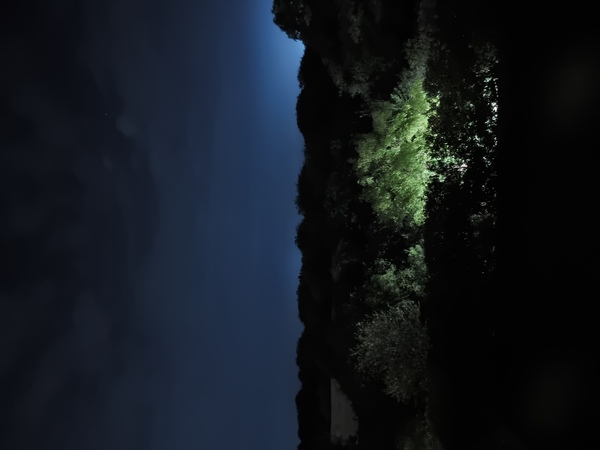
Night View from our Balcony
Since, I had a hectic few days before we started the trip and had gotten up early, we decided to take it easy on the first day and just relaxed. The architecture of the property in Hampi is based on the royal palace in Hampi including the open area in the middle with a water source to help cool the place. As we were planning to stay 3 nights we had 2 full days (and 2 half days) to explore Hampi, which was perfect because they have 4 trails for guests (Raya Trail, Vithalapura Walk, Tungabhadra Trek & Virupaksha Trail) which you can choose to go on. We decided to all 4 of them, doing one trail in the morning and another in the evening.
Second Day
We started off with the Vithalapura Walk, which is a walk through the ancient market and the temples of Vithalapura – a Hampi suburb known for the famous Vijaya Vithala temple that houses the renowned Stone Chariot and musical pillared mantapa. Our trip started early morning post breakfast to avoid the heat, the drive to the Vijaya Vithala temple was short and interesting because Santhosh who was our guide kept us entertained with stories about the historical city. We parked the car at the entrance and then walked to the temple. If we had come a little later, there are electric golf carts that will take you there but as we wanted to stretch our legs we walked the ~1kms distance and I am glad we did that because it gave us the chance to explore the area in more detail rather than watching it from the cart.
The first structure that catches your eye as you are walking is the ‘Kuduregombe Mandapa‘ (Horse riders Pavilion). It is named so because it has sculptures of horses with riders mounting them at its entrance and the word Kuduregombe translates to Horse Riders in the local language. This is a temple for one of the Hindu Gods and was built over 500 years ago. Unfortunately, over the years the idol was removed and much of the temple is in ruins so we don’t know for sure which of the Gods the temple was built to worship. Another theory is that it was used as a prayer place by the horse riders during the annual chariot festival.
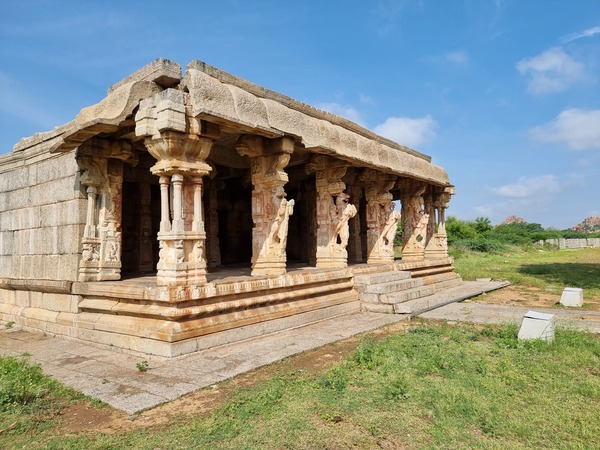
Kuduregombe Mandapa (Horse riders Pavilion)
Across from the Mantapa there is the remains of the temple pond which supplied the water to be used for the temple and for the drinking/cooking of the staff and visitors. The pond has steps going down to the water and when we went it was in poor shape as the water had stagnated and a lot of plant growth was there. There is a small structure in the middle of the pond where it is assumed an idol was carried out and prayers were done there before taking it back to the temple. Restoration work is going on in the rest of the compound, but they haven’t gotten around to here yet as there is a lot of work remaining. My sister has been working with various folks to map, photograph and look at rejuvenating step-wells around India as they are a sustainable way of water storage and distribution. (More on water distribution later).
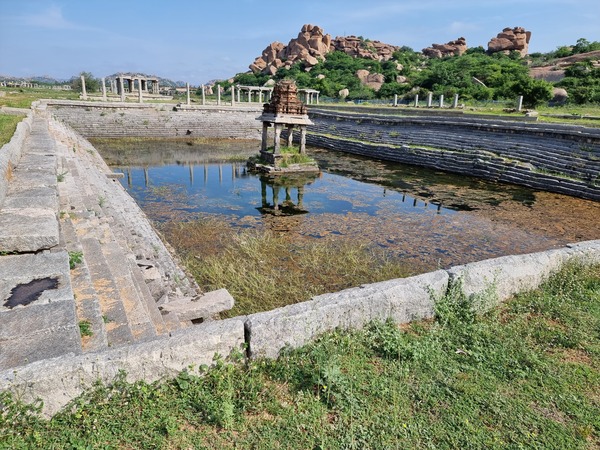
Remains of the temple pond, that supplied water to the Kuduregombe Mandapa
As you are walking down the road you will notice these stone pillars parallel to the road placed about 5-6 feet apart in rows. These are the remains of the market stalls that were placed for the vendors to sell their goods. Only the support structures remain as part the structure was made from wood and has decomposed over the years. The market at its peak was almost 1 kilometers long and had shops on both sides of the road. The market was host to merchants from all over the world, including Rome, Persia etc. At its peak the Vijayanagara empire was compared to the Roman empire by the traders and scholars who visited. It was rich enough that diamonds were used as decorations on the horse’s saddles and reins/bridle. In fact legend has it that Diamonds and other precious stones were actually sold by weight instead of per piece in this market because they were so common. There have been writings about this market (and others in the empire) by famous visitors from across the world. But hardly anyone knows about it.
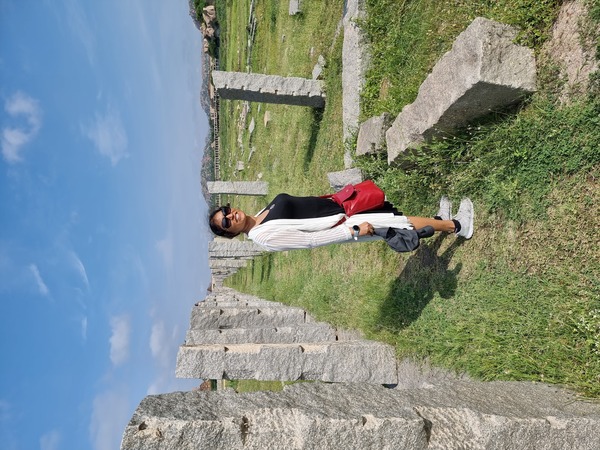
Remains of the Market stalls
During the walk we also spotted some brightly colored lizards (Agama’s) and other wildlife and plants that Jani found to be a lot more interesting than I did. Still they all looked very pretty 🙂
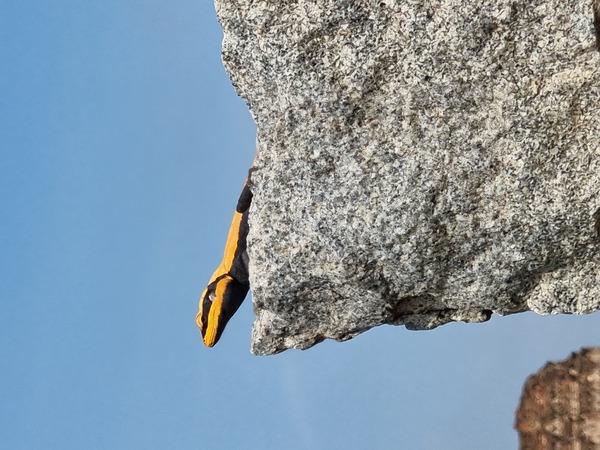
Another few mins of walk brought us to the entrance of the Vitthala temple and even in it’s current state the word that came to mind when I saw it for the first time was “Impressive”. The Vitthala temple was initially built in 1422AD and expanded between 1509-1529AD out of solid granite rock. The temple is dedicated to Lord Vitthala, who is an incarnation of Lord Vishnu.
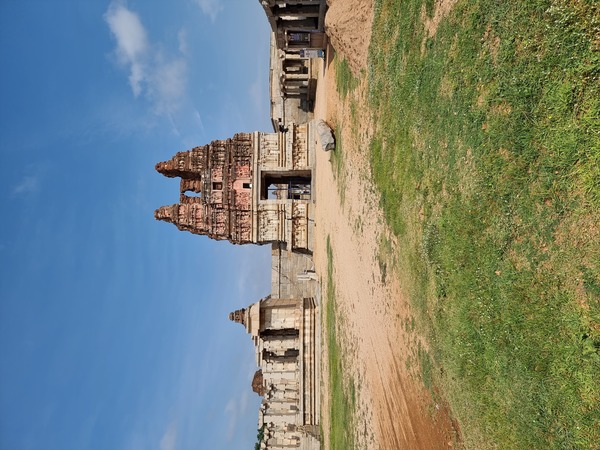
Entrance to the Vitthala temple
The temple complex is huge and a lot of restoration work is going on as parts of the temple is in ruins due to the age. Some of you might ask (as I did) why folks are not allowed to drive up to the temple and park right in front as there is enough space available there. This is not allowed because of the fear that the vibrations from the vehicles would damage the structure. Then Santhosh pointed out an ingenious method that is being used to monitor the cracks to ensure they are not expanding. In other countries, I have seen sensors being placed all over such structures to monitor the cracks, here they have taken a very thin strip of glass and stuck it over the crack. If there is any activity or increase in the crack dimension it will break the glass notifying the ASI staff that they need to check for damage. It is cheap, simple and very effective.
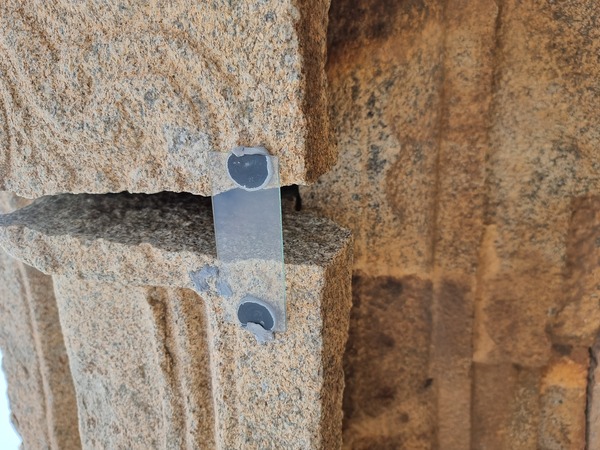
Cheap ‘sensor’ to monitor cracks on the structure
Once you enter the complex, the famous The Stone Chariot (Ratha) is right in front of you in the temple courtyard. The Chariot is a shrine to Garuda who is the vehicle mount (vahana) of Lord Vishnu. Garuda is also a dharma-protector and Astasena in Buddhism, and the Yaksha of the Jain Tirthankara Shantinatha. It is one of the three most famous chariots in India with the other two located in Konark and Mahabalipuram. The chariot was built by King Krishnadevaraya of the Vijayanagara Empire during the 16th century. It was created to showcase the beauty and artistic perfection of the Vijayanagara empire. The chariot is made of multiple slabs of granite but due to the skill of the craftsmen it looks like it is made from a single stone. A small example of the skill of the craftsmen is that even though the wheels of the chariot are made out of stone they were crafted in a way that they could rotate freely. (Now the wheels have been fixed in place to protect against damage). Originally the chariot had stone horses pulling it but the statues were damaged and have been replaced with elephants taken from another location.
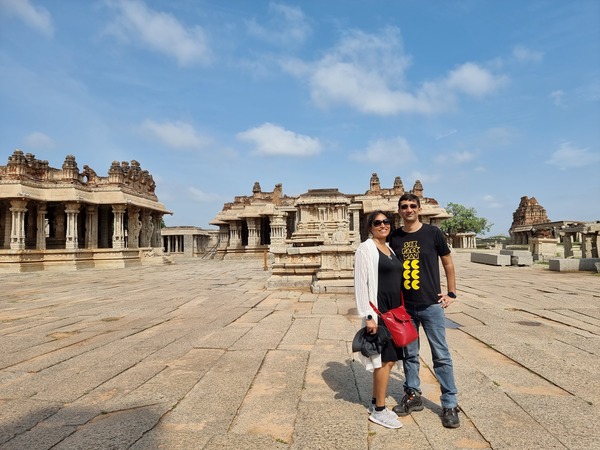
Us at the entrance of the Temple complex with the stone chariot right behind us
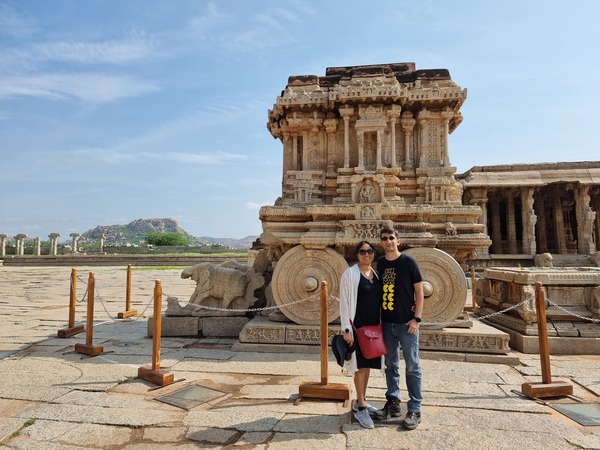
The famous stone chariot
The Maha Mantapa (Great hall) of the temple is behind the Stone Chariot in the in inner courtyard. The hall is built on top of a ornately carved platform from solid granite. The whole platform is covered with images from Mythology, flowers and other designs. The Mantapa was under repair when we visited and still was one of the most impressive structures that I have seen. The hall has 16 musical pillars that have been carved from a single piece of rock, each pillar has multiple smaller pillar carved in it. The carving is done in a way that when you tap on the pillar it creates a musical sound. Each pillar produces a different musical note and there is a carving on each pillar that denotes what sound will be produced when the pillar is tapped. Imagine the skill required to carve these pillars flawlessly. During festivals and events musicians would play music for the dancers by tapping on the pillars with short sticks. The pillars in the hall are curtailed from access to prevent folks from playing music on them to protect them from further damage as they are pretty old.
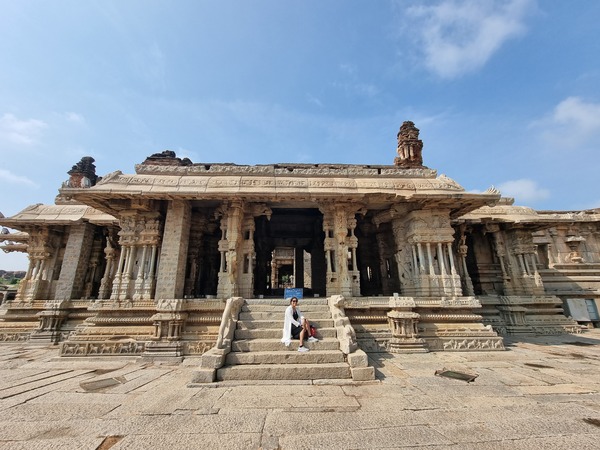
Maha Mantapa, Vitthala temple
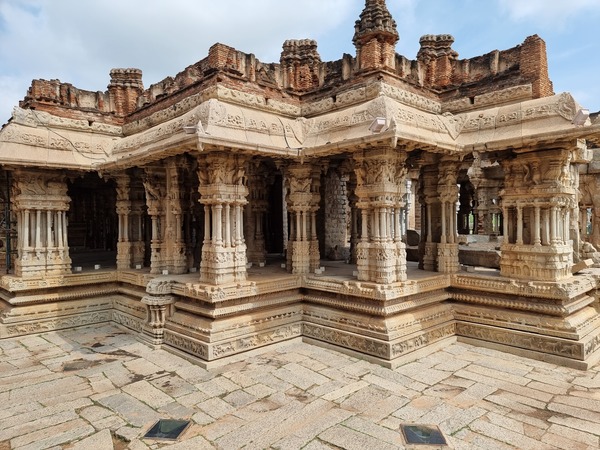
Maha Mantapa, Vitthala temple
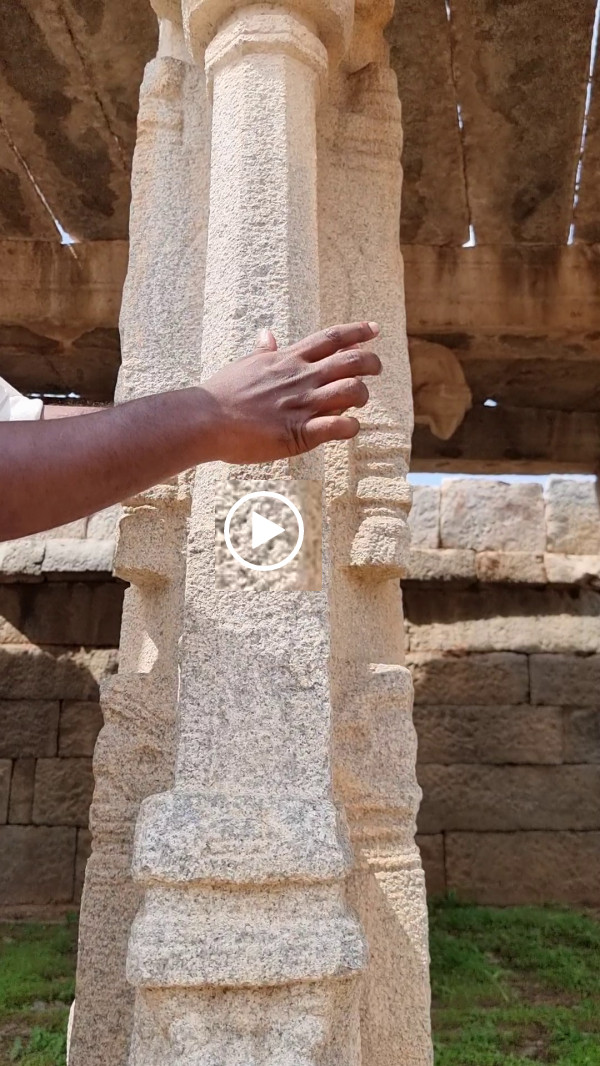
Sounds produced by Playing the Musical Pillars
The skill of the carvers is evident from the intricately carved water channels in the platform that are part of the design (see photo below).
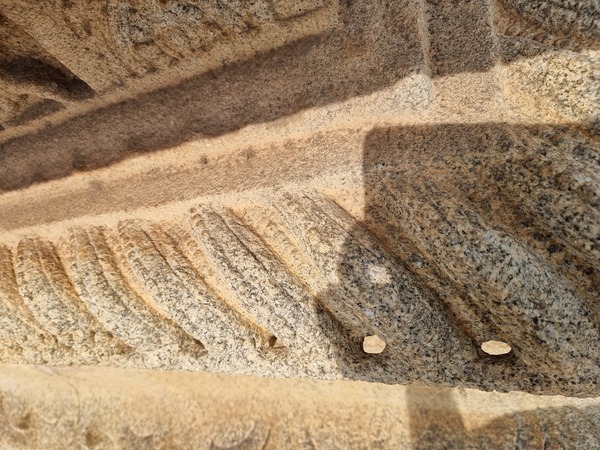
Carved water channel to safely channel water from rains into drainage.
Other pillars in the hall are covered with carvings that tell the story of Narasimha and parts of the structure tell the story of Hanuman’s visit to Lanka and Lanka Dahan (The burning of Lanka). What I found very interesting was the carving of the king riding a mythical creature with the parts of various animals each symbolizing a different virtue. Unfortunately I forget what each animal was supposed to represent and I will update the post once I find the details.
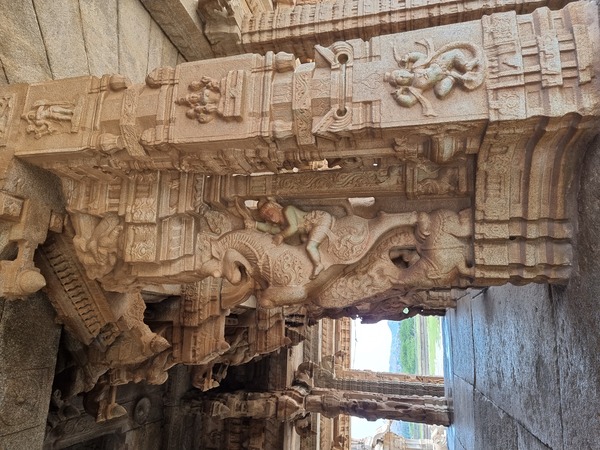
Carvings on the temple pillars
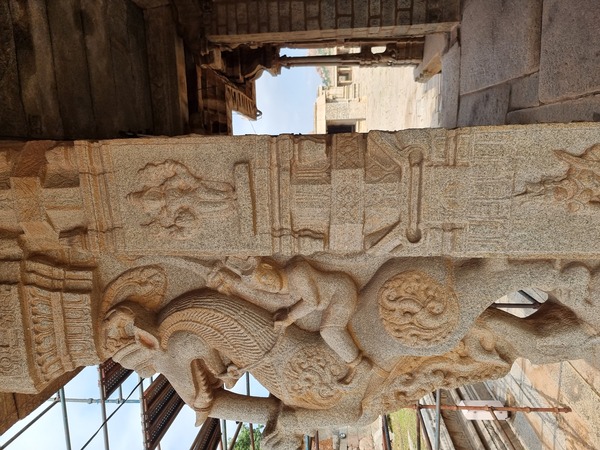
Carvings on the temple pillars
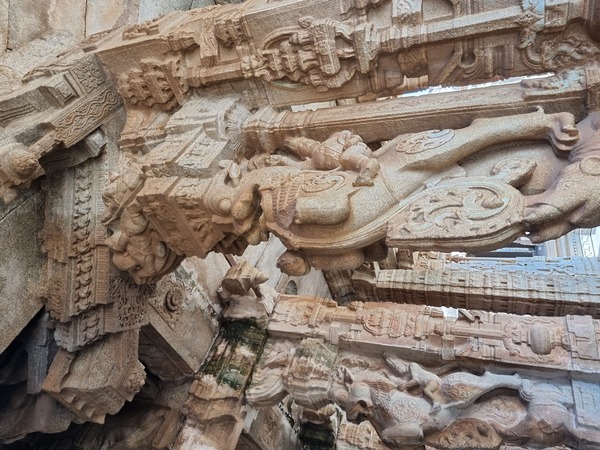
Carvings on the temple pillars
Another cool aspect that Santhosh pointed out was something that had never occurred to me even though I was aware of the components. He basically told us that the various avatars of Lord Vishnu tell us that our ancestors were aware of the theory of evolution and his avatars evolved over the ages to show how life evolved from marine life to the current form. Evolution teaches us that we went through the following stages of evolution and each avatar corresponds to that stage:
Marine life -> Matsa (Fish) avatar)
Amphibious Life -> Kurma (turtle avatar)
Simple Animals -> Varaha (boar avatar)
Early humans (like Australopithecus Afarensis) -> Narasimha (man-lion)
Tool Users/Farming (like Homo Habilis) -> Vamana (dwarf-god)
Warriors -> Parashurama (Brahman warrior)
Civilized Man -> Rama/Krishna
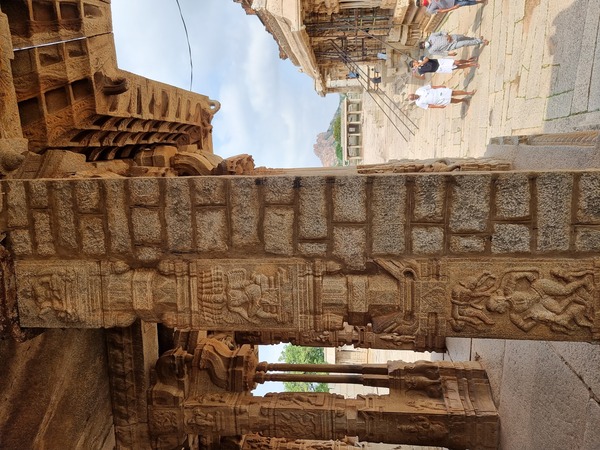
Pillar carving showing Hanuman’s Lanka Dahan
Each of the other smaller halls are also covered with carvings and paintings. If I wanted to detail each aspect of the carving this post would end up becoming a book so I am not going to do that as there are others with more knowledge who have written about the temple and what all the carvings mean. By the time we finished the complex, it was starting to get a little hot so we rested for a while next to the 100 year old Temple Flower tree and then headed back.
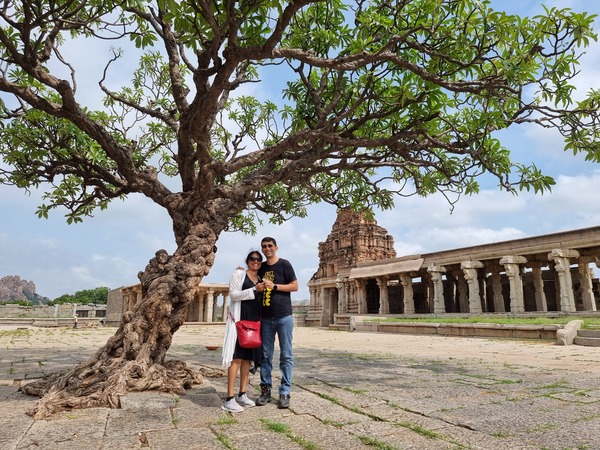
Ancient Temple Tree
After reaching the resort we rested for a bit. As we had to head out again (and since we were hungry from our outing) we took an early lunch and were ready for our next Trail called the “Raya Trail. This trail started with a visit to the Queen’s Bath. The Queen’s Bath was created by Achyuta Raya over 500 years ago for use by the Royal Women. It is an interesting structure surrounded by a moat on all sides which served the dual purpose of preventing any strangers from entering the building while it was in use and secondly to help cool the building during the summer days by evaporation. The building is designed in an Indo-Islamic style as during the time it was built, there was a lot of cultural exchange happening between the Vijayanagara empire and the Muslim kings (Moguls and their followers).
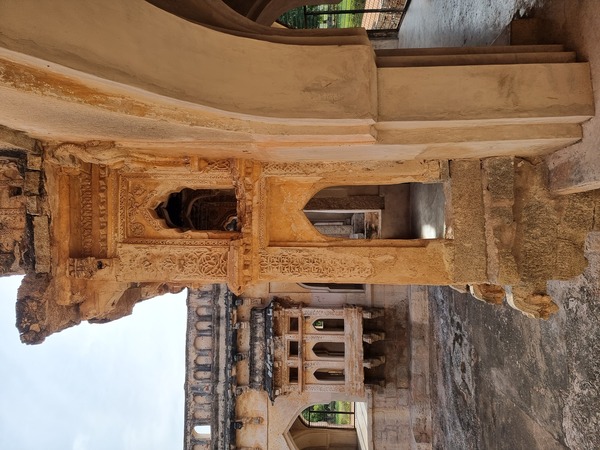
Carved windows in the Queen’s Bath
The center part of the structure is currently open to the air but it is believed there was a wooden canopy over the structure when it was in use. The halls around the bath have beautifully carved pillars and balconies and it is easy to imagine the splendor of the bath in it’s prime. The bath was supplied with water via ingeniously designed aqueducts and some of that original network is still in service and used to supply water to parts of the city and fields.
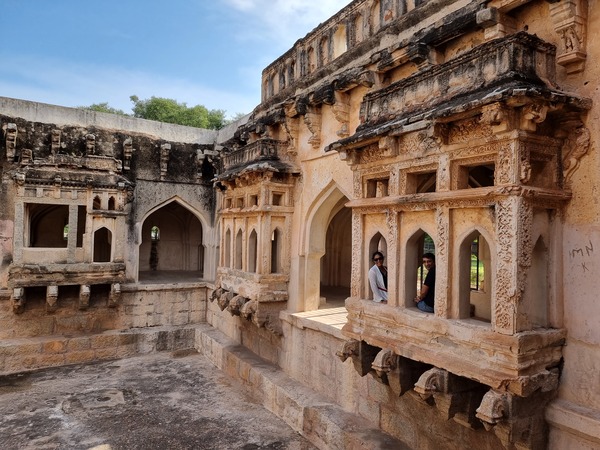
Ornate windows overlooking the bath at Queen’s Bath
After the bath we visited the Zanana Enclosure (Women’s Enclosure) which contained the residences of the Queen and her ladies. The enclosure is surrounded by a massive wall built to protect the women against attack while the men were away for war. Due to ravages of time only the foundations and the base of the buildings are left in the enclosure as the buildings are said to have been built using wood which decomposed over the years. The most famous structure in the enclosure is the ‘Lotus Mahal’ which was the primary residence and contains lots of geometric windows and ingeniously designed cooling pipes to reduce the temperature during the summer months.
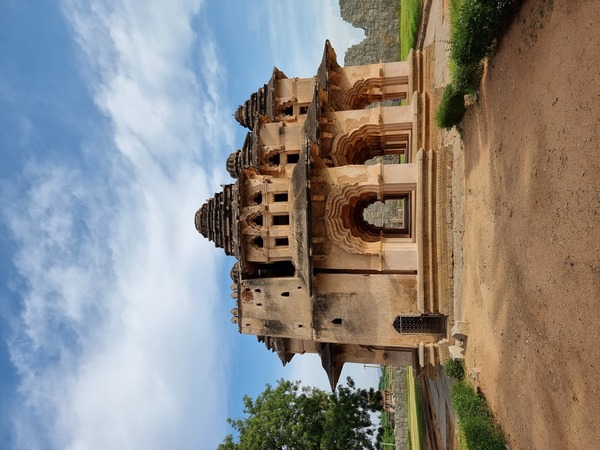
Lotus Mahal
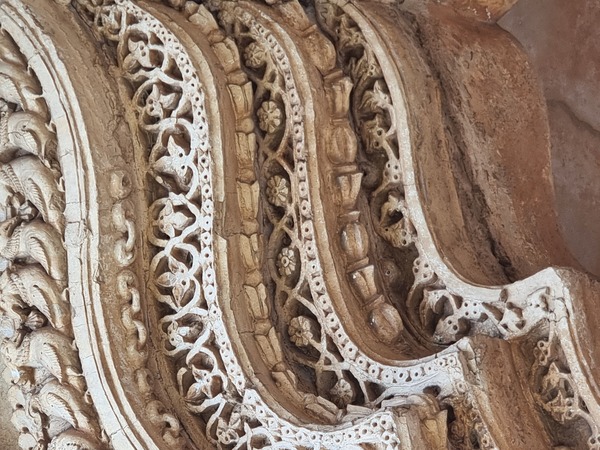
Carved designs around the cooling piles (that spray water)
Our next stop after the Enclosure was the ‘Elephant’s Stable’, where the king housed his famous elephants. The stable was built in the 15th century and is a massive domed structure. Each dome is a different type such as circular, octagonal or fluted. The structure was covered with plaster and Stucoo ornamentation and the remains of the same can be seen in both the exterior and interior of the stable. The mahout’s (Elephant rider/trainer) residence is right next to the stable so that they could care of the elephants.
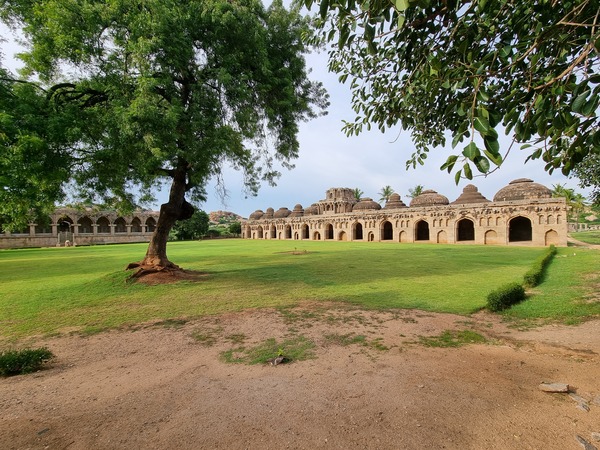
Elephant’s Stable
After the stable, we visited the Madhava (Ranga) Temple which is famous for the Hanuman statue inside it which is over 3 meters high. The pillars in the temple are carved with depictions of Garuda, Vitthala, Hanuman and depictions of other Gods & Goddesses.
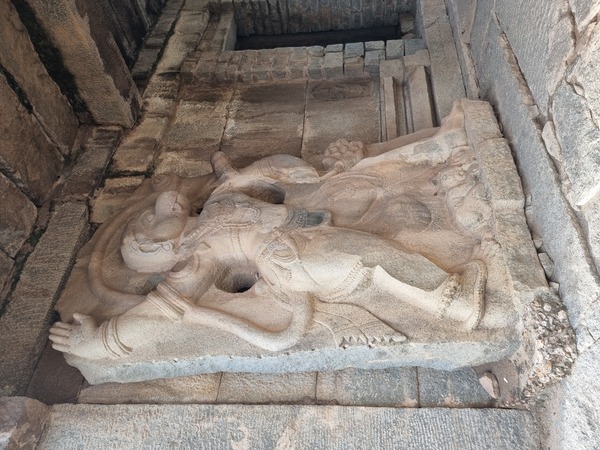
Hanuman statue inside the Madhava (Ranga) Temple
The final stop of the day was the ‘Royal Enclosure’ which was the core of the capital city of Vijayanagara. It housed over 43 buildings for the civil servants that managed the day to day running of the empire. The main entrance to the enclosure was guarded by a pair of massive gates which admitted visitors to a zig-zag area that took the visitors to the ‘Mahanavami Dibba’ platform. This platform was where the king accepted vows of fealty from his subordinates, showcased their military might and performed prayers for victory before any military campaign. Each layer of the platform is decorated with carvings showcasing the military might of the empire, their cultural achievements, representation of visitors from other nations and the tribute they offered (that included, exotic animals, dancers etc). You can see depictions of merchants and ambassadors from the Chinese, Mesopotamian, Persian and other major empires in the world.
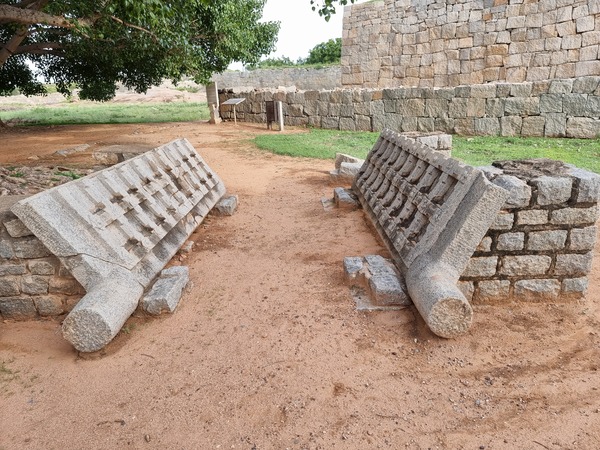
Massive Stone Gate protecting the entrance of the Royal Enclosure
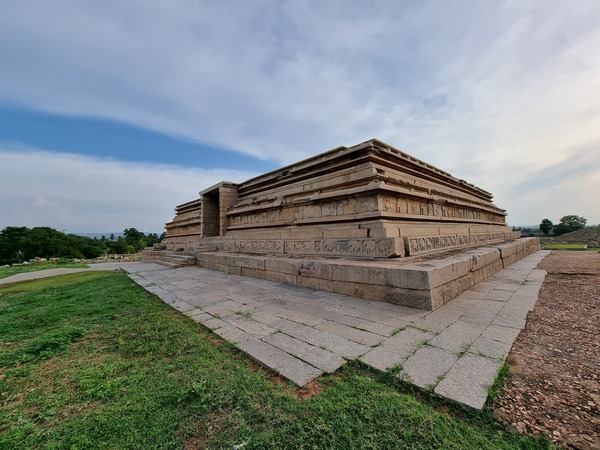
The ‘Mahanavami Dibba’ platform
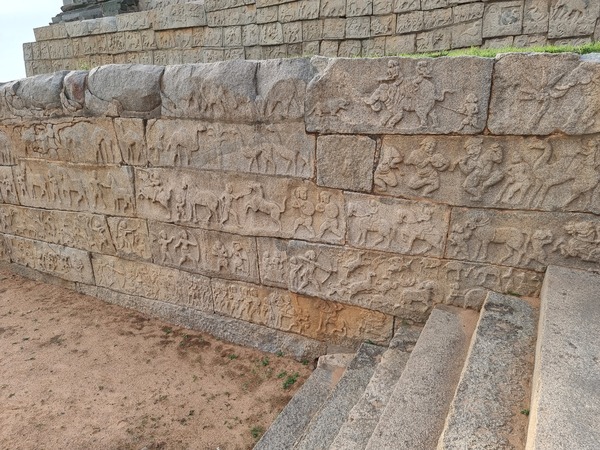
Ornate carvings on the side of the ‘Mahanavami Dibba’ platform
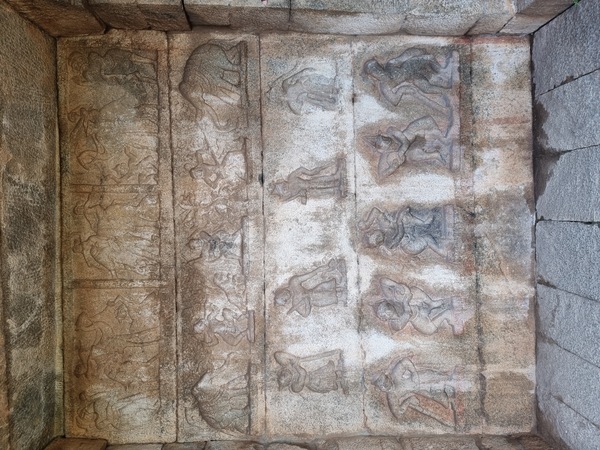
Carving showing some of the visitors to the empire from around the world with the gifts they brought
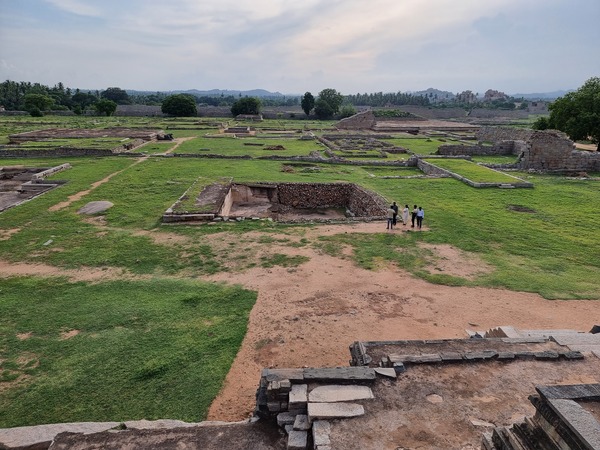
View from the top of the Platform
Some of the other structures in the enclosure include grain storage area’s and water storage wells. Interestingly, each block of stone used to build these structures has a maker’s mark on it along with marks that tell the mason where exactly this stone was meant to be placed. In case of damage they would carve a replacement and replace that stone without having to measure the original again.
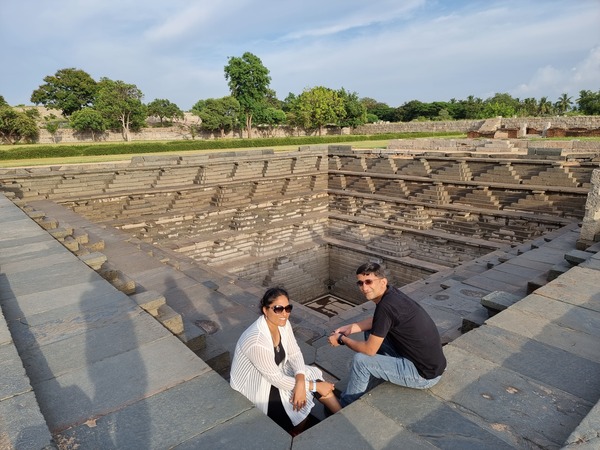
The main water storage for the Enclosure
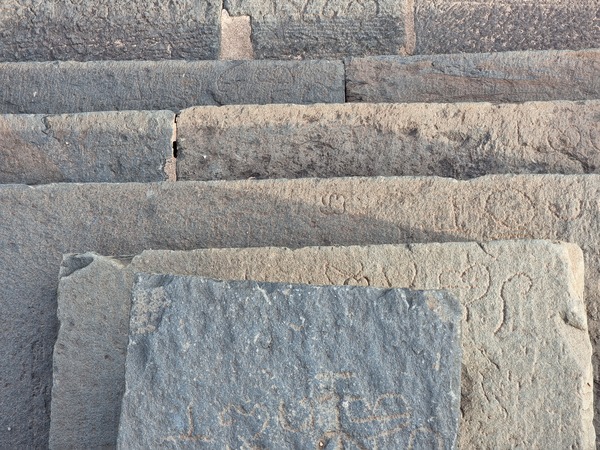
Maker’s mark on the stone used to build the structures
The enclosure also had provision for soldiers to camp and right next to the aquaduct supplying water there is provision for the soldiers to have their meals in massive stone plates. (I am trying to convince dad to get some stone plates for home).
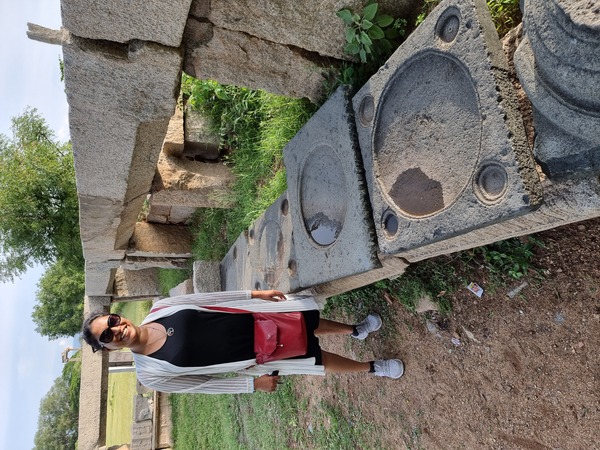
Massive stone plates for soldiers to have their meals on
The last stop of the day was the ‘Hazararama Temple’ that is the only temple located in the core zone of the royal Enclosure between the residential and ceremonial enclosures. The temple is dedicated to Lord Rama and is a great example of the Dravida Vimana Temple style. The temple is famous for the carvings and sculptures telling the story of Ramayana in three tiers.
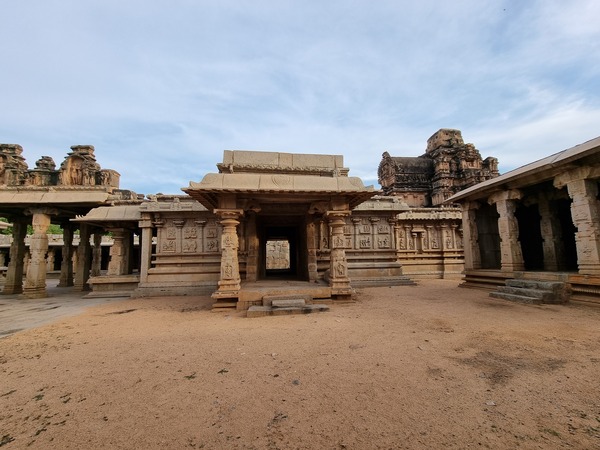
The ‘Hazararama’ Temple
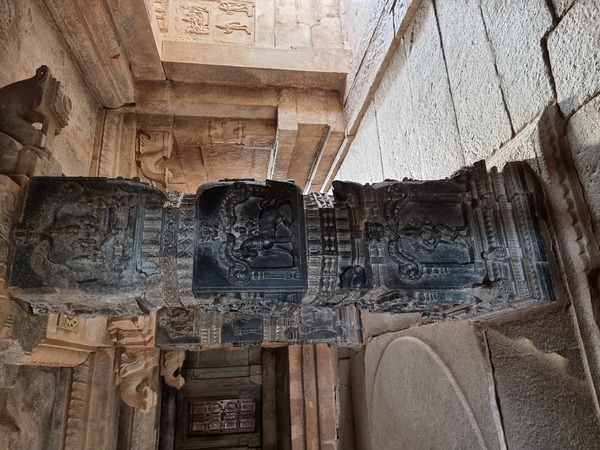
Carved pillars at The ‘Hazararama’ Temple
With is visit, we concluded the first day of our trails and headed back to the resort where after freshening up we rested for a little while enjoying the cool breeze and then had our dinner in the Specialty restaurant called Bahmani. Continuing with the theme of giving us a really VIP treatment the staff seated us next to a lotus pond near the window where we got to enjoy the nice breeze and watch the rain while staying dry. The food was again fantastic and we really liked the meal and the service.
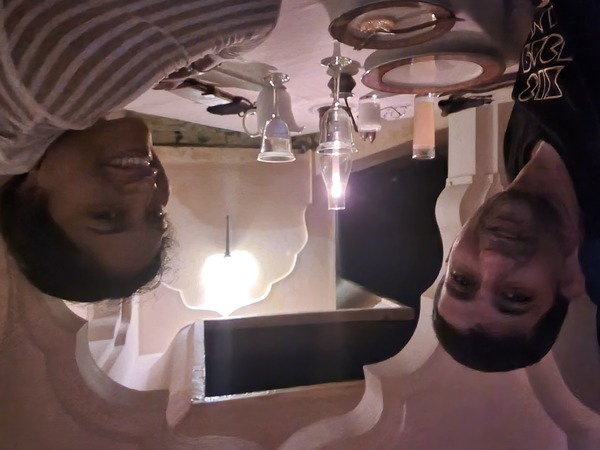
Pond side seating at Bahmani for dinner
Third Day
The third day of the trip started with a heavy breakfast followed by us heading out to the ‘Virupaksha Trail’. We drove to the beginning of the trail and started with a visit to the ‘Saisivekalu Ganesha’. This is a 2.4 mtrs high statue carved from a single rock which was built around 1506 AD, as per an engraving on the rock next to the pavilion. The statue is in an open pillared pavilion that has been standing for centuries without any mortar/cement being used in it’s construction. The whole thing is balanced to an inch and even falling rocks have not damaged the structure.
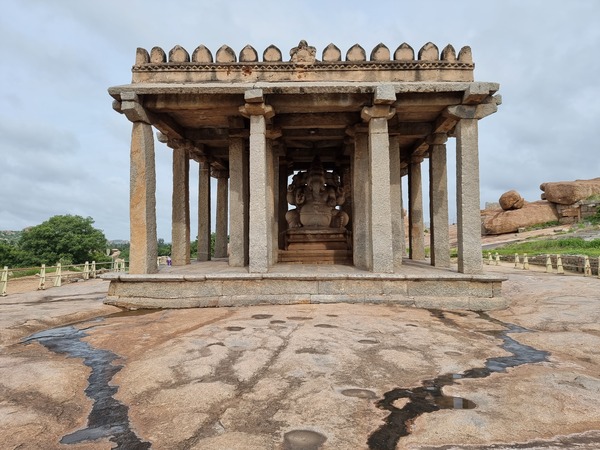
the ‘Saisivekalu Ganesha’
Next to the pavilion, there are a lot of rocks which were prepared for construction and here is where I found out how the ancients broke these gigantic rocks into smaller pieces or slabs without using any kind of power tools. First they locate the fault line in the rock and carve rectangular holes in the stone using chisel & hammers. These holes are then filled with hot water and left for a bit, then they immediately fill it with cold water. They repeat this for about 10-15 days to allow the hot & cold water to expand & contract the rock to start expanding the fault line. At times, they also insert wooden pegs in the holes that are wett’ed with water which forces the wood to expand forcing the cracks to widen. Once they judge enough time has passed and the stone is ready, they use a hammer and chisel to strike hard blows at key points on the rock and it everything was done correctly the rock splits apart easily. The process was then repeated if smaller pieces of the rock were required.
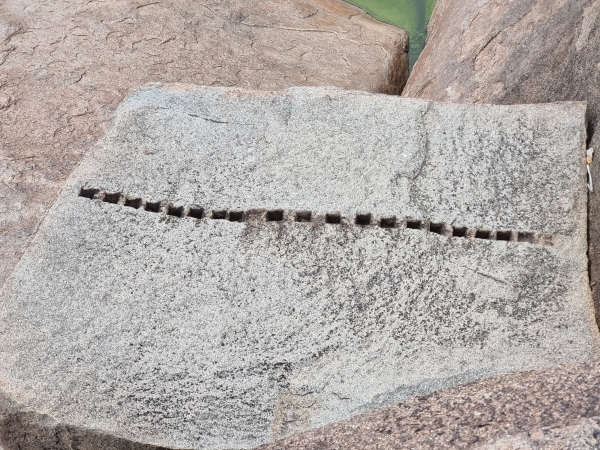
Square holes in the rock made to cut the rock
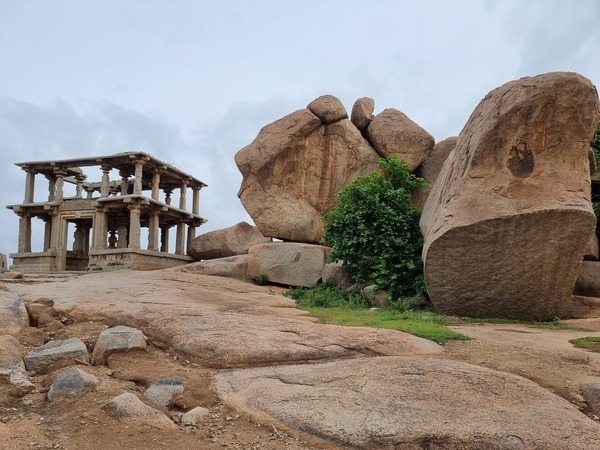
Massive rock cut in half using the method above
The walk from the Ganesha statue to the Virupaksha temple is quite nice and you can see how the temples evolved over the years. In the beginning there Shiva linga is carved into the rock right in the open, then a few years/decades later the first structure is built around the idol/Shiva linga which is a simple room, with rudimentary carvings on the temple. Carvings are not very detailed because the rock is extremely hard and difficult to carve. Then the later temples built a room around the central room with additional carvings and more idols. Around this time other stones were used in the construction along with Granite so the carvings start becoming more detailed as well.
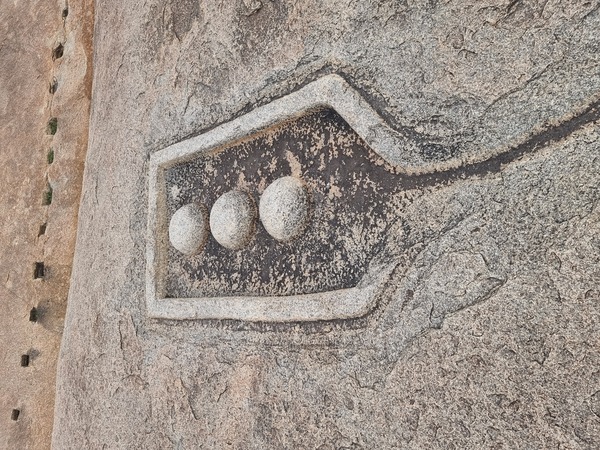
Shiva linga’s carved in the rock in the open
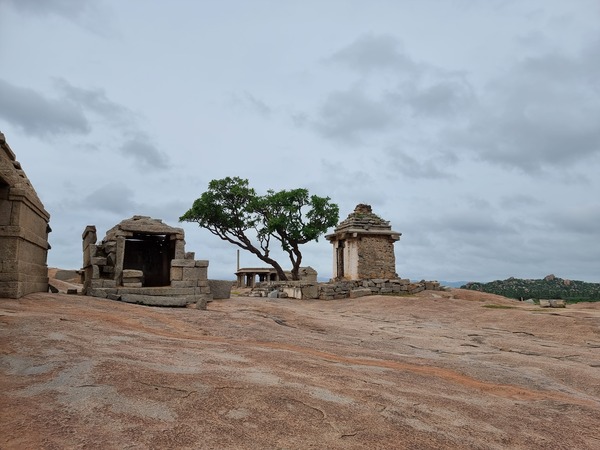
Single room temple
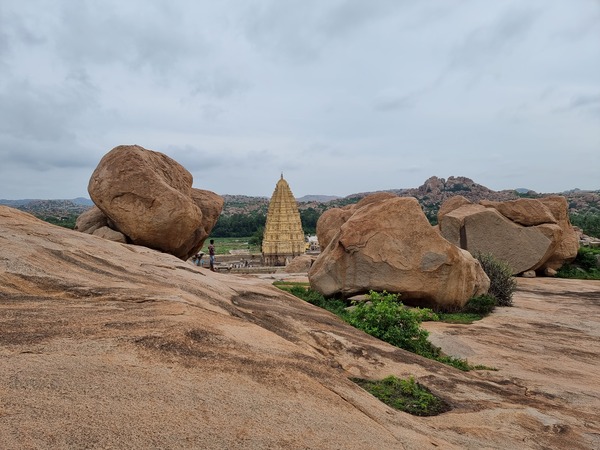
View of the Virupaksha temple from a distance
A short walk down the hill brought us to the entrance of the famous Virupaksha Temple. The Virupaksha Temple is dedicated to Lord Shiva and has existed since at least the 7th century as there are records of the temple from the 7th century onwards. The temple was built by Lakkan Dandesha, under the ruler Deva Raya II of the Vijayanagara Empire. It started off as a simple shrine and over the years was built into a a huge complex during the Vijayanagara rule. The carvings of the temple are phenomenal and cover almost all the pillars and roof. The temple base is made from rock with the top portion made from brick. This allowed the architects to create very intricate carvings on the temple as brick is easy to carve and shape as compared to granite.
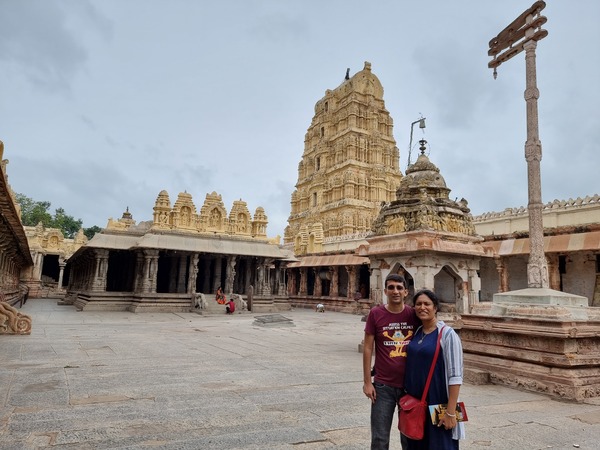
Inner Courtyard of the Temple complex
The temple has a lot of repeated patterns in it’s design and if you look carefully you can see the patterns demonstrate the concept of fractals. The patterns divide and repeat themselves as they become smaller and smaller. The roof of the temple is covered in beautiful paintings with some of the original colors still visible.
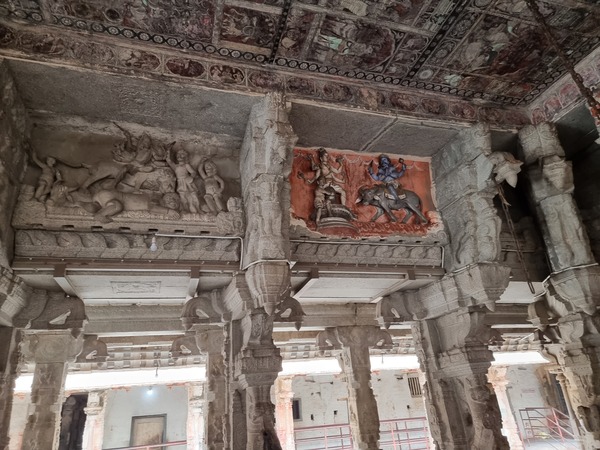
Carvings showing scenes from the Ramayana in original color
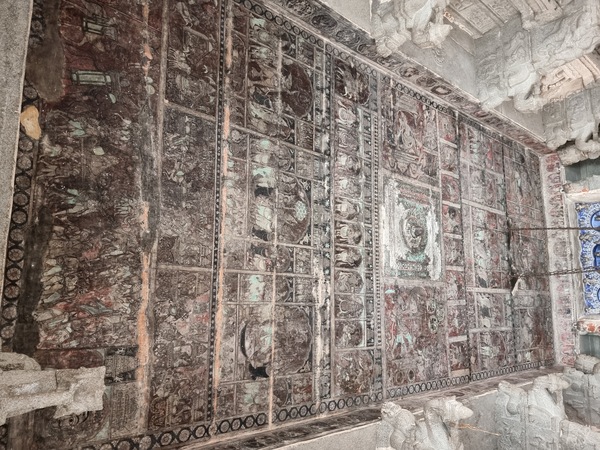
Roof Paintings inside the temple complex
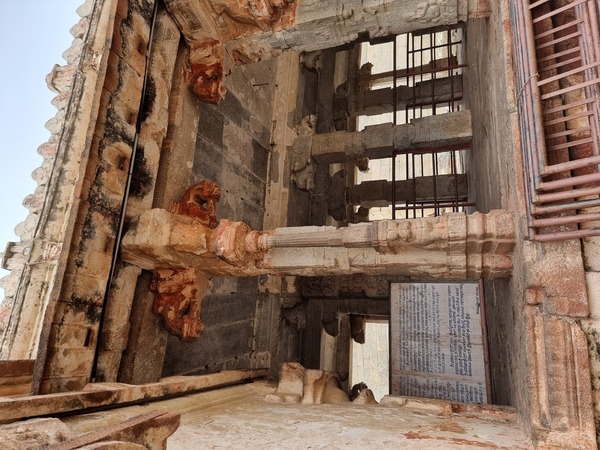
Carved pillars in the temple.
One aspect of the temple, which is not known to many people is that it is designed in a way there is a small pinhole camera that shows us the top of the temple as an inverted image within the main temple in a small room off to one side of the main shrine. Things like this were what made it worth going on the trail with the staff from Evolve Back as they show you stuff that you would have missed otherwise.
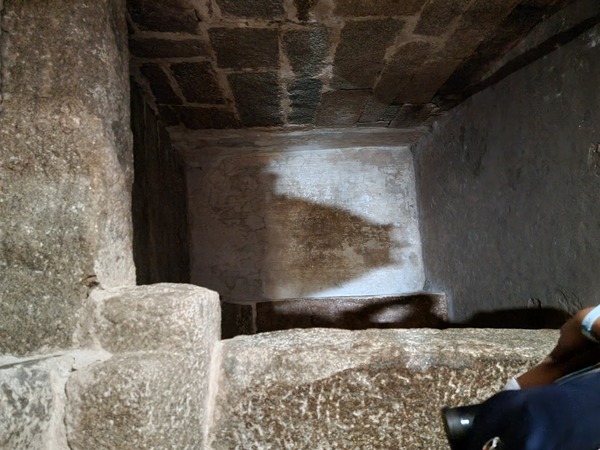
Pinhole camera showing the top of the temple next to the shrine
The complex had a lot more decorative structures in and around it which were destroyed by the Muslim invaders in the 16th century. Which is extremely depressing when you think about it. How much of India’s culture and history was demolished by these invaders?
While walking around the complex we walked over to see the step well that functioned as the water storage area for the temple use. The structure is still in use and had fishes in it that you can feed. We didn’t but others were feeding them as we watched.
Post that we walked over to the ‘Kadalekalu Ganesha‘ statue, which is the largest Ganesha statue in South India. It towers over you at a height of 4.6 mtrs and is known as Kadalekalu Ganesha because its belly was carved in the shape of a Bengal Gram (Kadalekalu in the local language). The statue sits in a temple hall that is decorated with tall and slender granite pillars carved with various mythological characters and themes. We spent a few minutes resting in the shade here and then started the drive back to the resort.
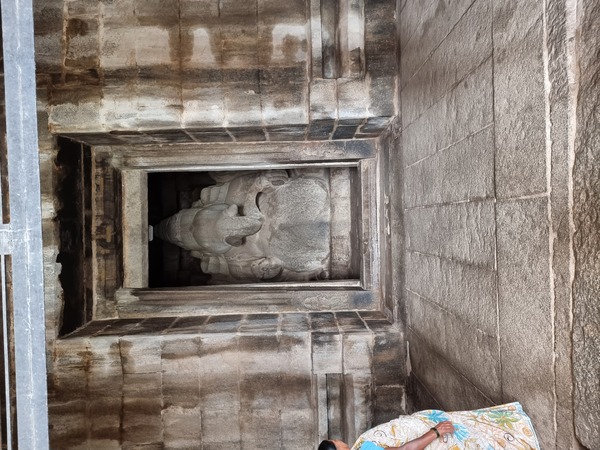
The ‘Kadalekalu Ganesha‘ statue
On the way we stopped at the Lakshmi Narasimha Statue which is another major tourist attraction in Hampi. It is also known as the Ugra Narasimha or Angry Narasimha. It was built in 1528 AD and is dedicated to Lord Narasimha (an avatar of Lord Vishnu), and Goddess Lakshmi. The statue of Lord Narasimha is sitting sitting cross-legged position on the coil of a giant seven-headed snake Adishesha and originally had a small figure of Goddess Lakshmi sitting in his lap to keep him calm. The statue was vandalized by the Mugals during their attack and the limbs of the statue were broken along with the Lakshmi statue. The damaged Lakshmi statue is now kept in the Archaeological Museum in Kamalapura for safekeeping.
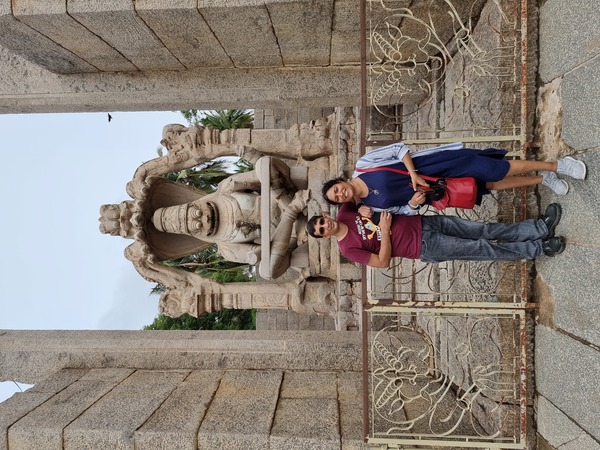
Lakshmi Narasimha / Ugra Narasimha Statue
Right next to the statue is another famous temple dedicated to Lord Shiva called Badavilinga Temple. Badavilinga is a combination of two words – Badva (Poor) and Linga (Shiva) in the local language. It is called so because legend has it that the Shivaling inside the temple was commissioned by a poor farmer lady. In her honor the temple is known as the Badavilinga Temple. The Linga in the temple is surrounded with water to keep Lord Shiva calm and control his destructive dance.
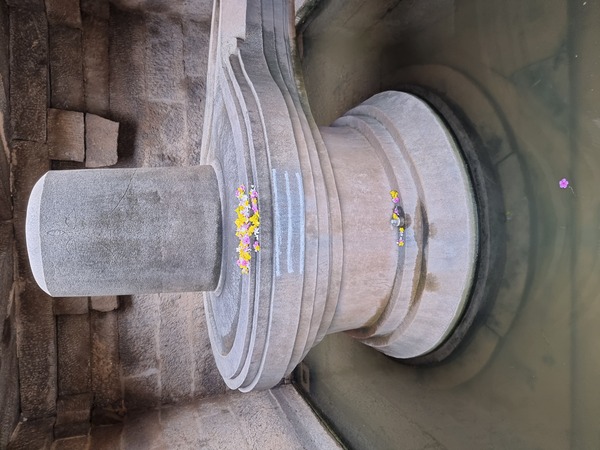
The Badavilinga Temple
Awed by this grand tour we drove back to the resort where we rested for a while before heading out for lunch. Lunch was great as usual and after a short rest we were ready to tackle the next (and the last official) Trail of the resort, the “Tungabhadra Trek“. While we were waiting to head out, Joydeep who is the General Manager for the Hampi property stopped by to check on if we were enjoying the stay. During the conversion he mentioned that they had just completed the recce for another Trail that they were planning on starting in the future which was something that most people didn’t know about. This was to a site (Hire Benakal) that contains structures between 3000 to 4000 years old with rock paintings from the same time. Since both of us love history and wanted to ensure we visited this place, we asked them if they could organize a trip for us to this place (More details in the next post). They agreed to take us out to visit the Hire Benakal but only if we extended our stay by a day because it was a half day trip to visit the location. We immediately asked the staff to extend our stay by a day and then started off for the Tungabhadra Trail.
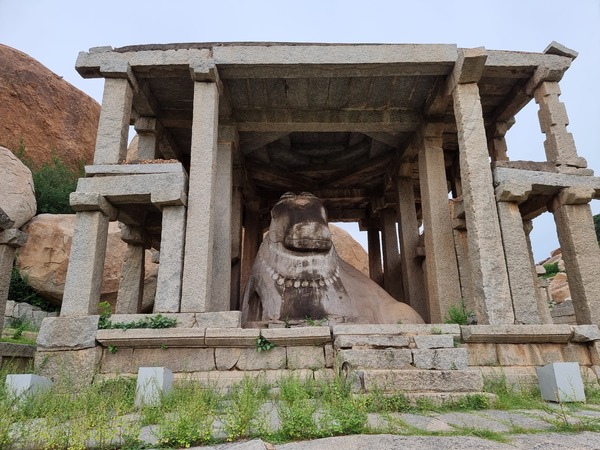
Nandi Statue at the start of the Tungabhadra Trail
We were joined by Mr Sarath, who is the Associate Director of Conservation and Experiences on this trail along with Santhosh. We then drove over to the start of the trail which has a giant statue of Nandi at its beginning. The statue is looking towards the Vittala Temple and overlooks the entrance. This trail is a little more hiking than the other trails we did till then at Hampi but was a fairly easy climb. Due to the monsoon season starting the whole climb was through some amazing greenery and we could hear a lot of wildlife such as birds and other small animals. The area is wild enough that there have been sightings of panthers and bears at times. Near the trail there was another trail that takes you to a cave that is said to be the location where Sugriva hid from Bali during their fight and his exile. We didn’t have time to visit it, but are planning to do so during our next visit.
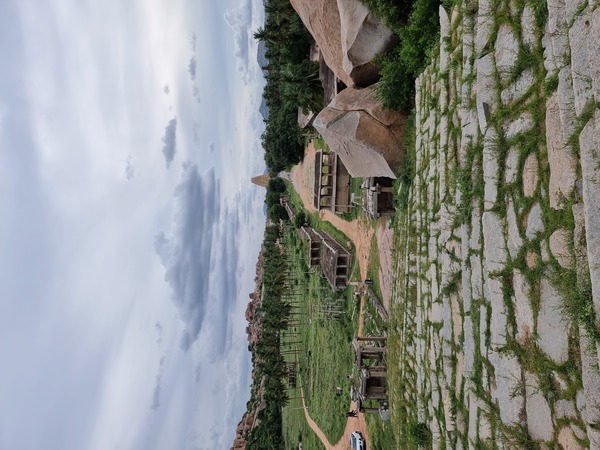
View of the Vittala Temple from the trail
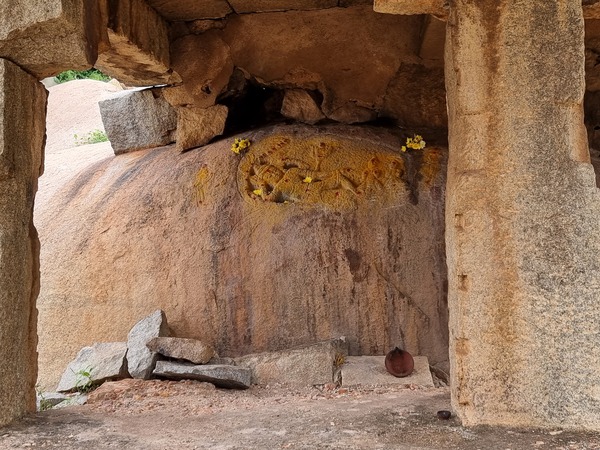
Carved image of Vishnu (I think) on the way to the Achyutaraya Temple
A short hike brought us to the Achyutaraya Temple, which looks like the temple from the Jungle Book which is the home of King Louie. As per Santhosh this temple was the inspiration for the ruined temple in the movie. The complex is huge and mostly abandoned with hardly any visitors. There is a way to come to the temple via the river which is where the main entrance used to be. The entrance we came through was the side entrance only used when the river entrance was flooded and couldn’t be used. The complex is covered with beautiful carvings which tell the story of Ramayana. It was built in 1534 AD and is dedicated to Lord Tiruvengalanatha (a form of Vishnu). The main entrance has the remains of a massive market in front of it and traders from all over the world came there to trade.
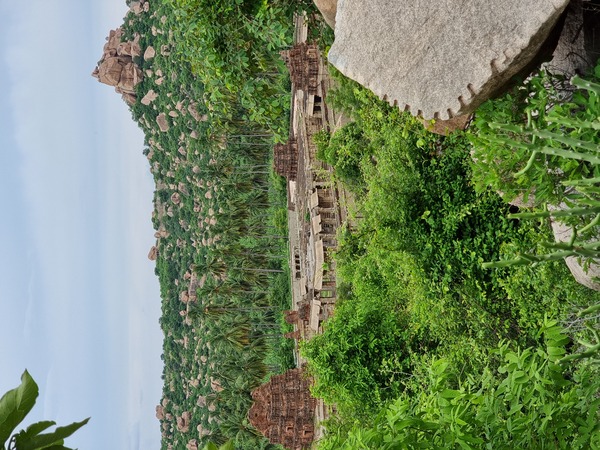
Achyutaraya Temple, hidden in the forest
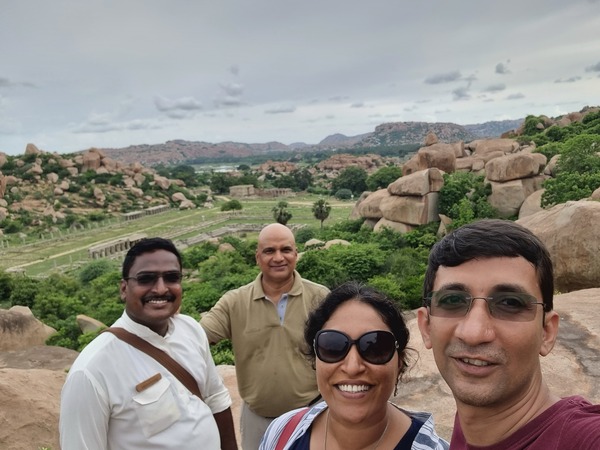
Selfie overlooking the Market at the Temple entrance.
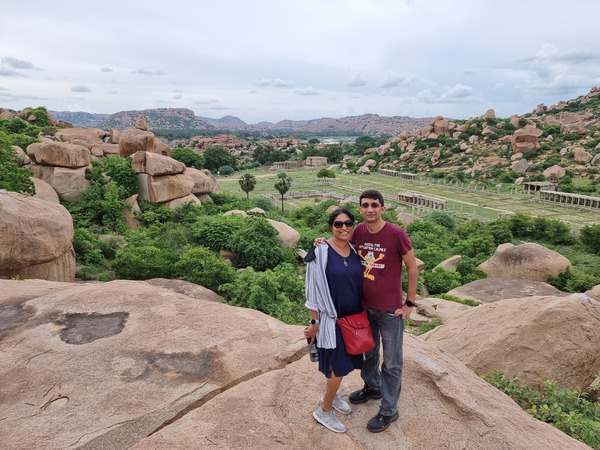
Us overlooking the Market at the Temple entrance.
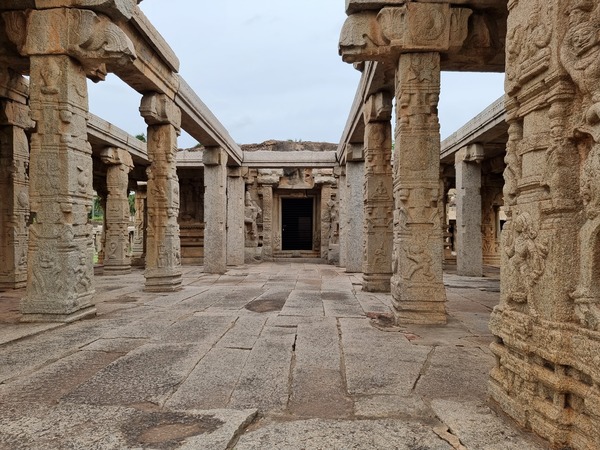
Carved Pillars inside the Achyutaraya Temple
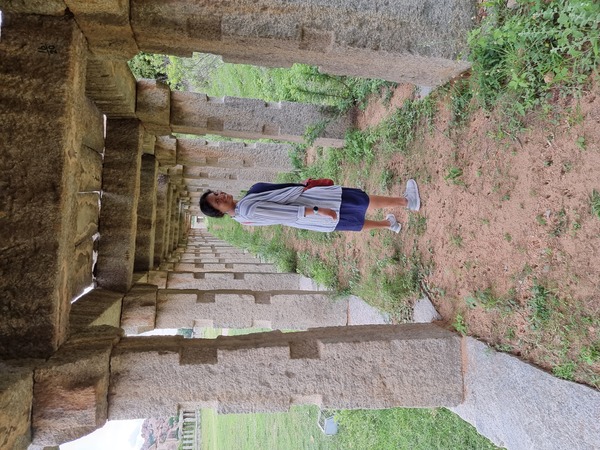
Walking through the Market Stalls at the Temple entrance.
We walked through the complex, and over to the Kodanda Rama Temple on the banks of the Tungabhadra river. The temple overlooks the Chakratirtha, which is is considered to be one of the holiest places in Hampi. Legend says that this is the place where Lord Shiva gave the Chakra Lord Vishnu which is his most powerful weapon. While we were there some shooting was going on for some documentary and due to this we got a highly decorated Coracle instead of a plain looking one. Initially I wasn’t too interested in a coracle ride but then was convinced to go for it as it was the only way to see the ruined temple and the shiva lingas.
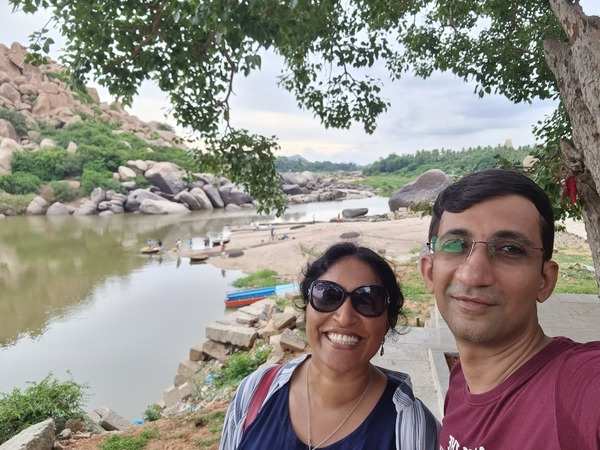
Overlooking the Chakratirtha
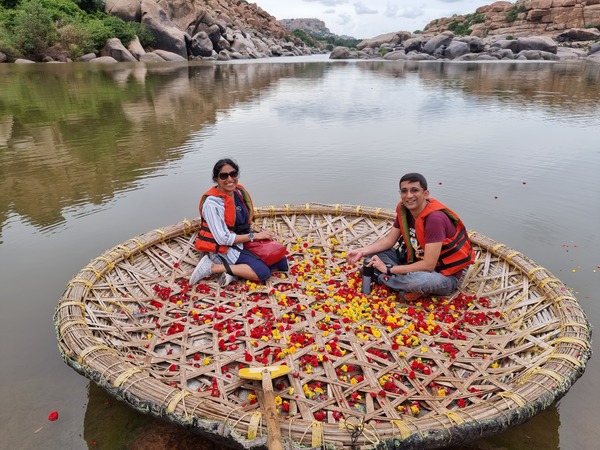
Coracle ride to the ruined temple
The coracle took us to remains of temples on the bank of the Tungabhadra river and these really detailed carvings of Gods & Goddesses done on the rock itself. A short climb brings you to the highlight of the trek which is a collection of 100 Shiva Lingas in the rock with another set of 1000 Shiva Lingas in the background. Imagine the effort and skill required to carve these without a single mistake on a surface as hard as Granite. After looking at all the amazing carvings we climbed back to the coracle and came back to the Chakratirtha from where we took another trail to the car.
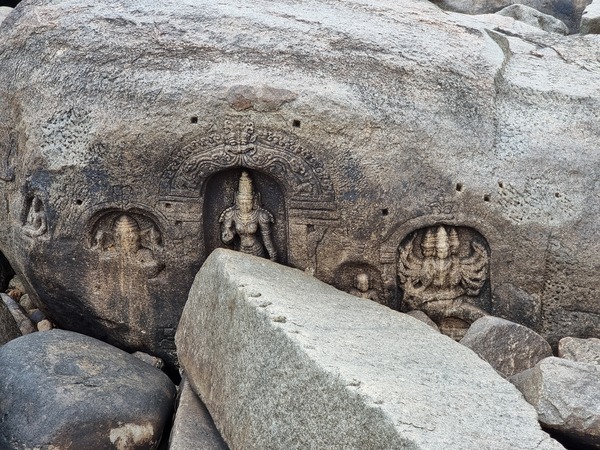
Remains of the temple carvings in the rocks
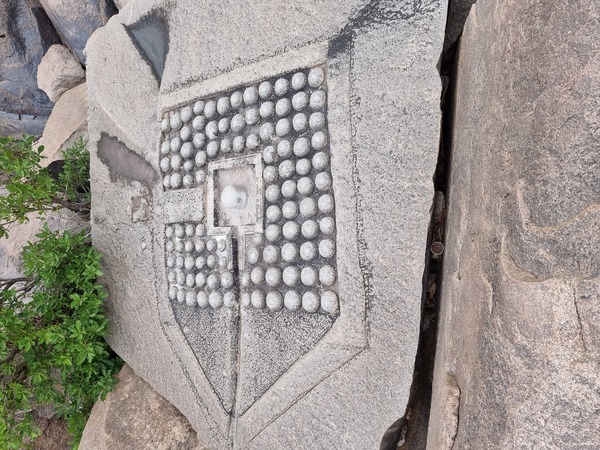
100 Shiva Lingas carved in stone
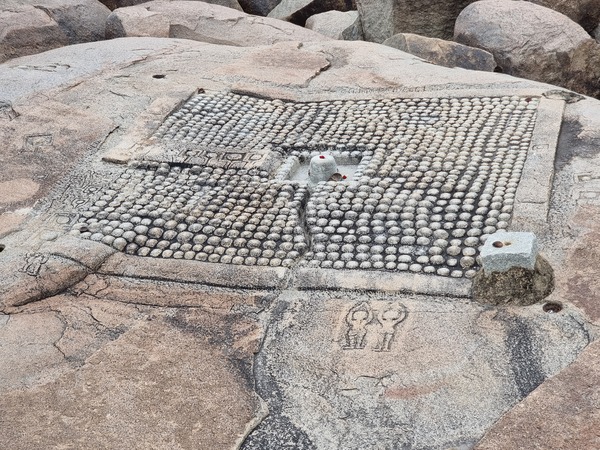
1000 Shiva Lingas carved in stone
On the way back to the resort we stopped at another structure that not many people know about, this was the Akhada (a place of exercise/martial practice with facilities for boarding, lodging and training) used by the king’s soldiers and visitors who wanted to compete and show off their skills for hiring. The walls are covered with carvings showing various forms of exercise and fighting forms. Even though the place is a little overgrown it is still impressive.
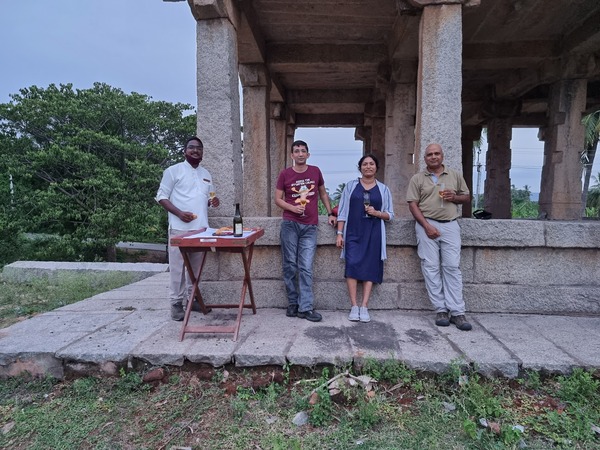
Tea break at the Royal Akhada
We had a small tea break at the place before we headed back to the resort. By this time the team had confirmed our extension of stay even though we didn’t get the same room we were still glad that we got to stay another day. After a short rest, we went for dinner. Since we had liked the specialty restaurant a lot on the previous day the team again booked us for the specialty restaurant with the same seating location as the previous day. By this time a lot more people had checked in to the resort so the place was full but since we were off in our own alcove we were able to ignore the crowd and felt that we were the only people there for dinner.
Finishing dinner, we headed back to the room and crashed for the night as we had an early start the next day. This completes Part 1 of the write up of my Hampi visit. Part II focuses on the visit to Hire Benakal and will be published shortly.
Well this is all for now. Will write more later.
– Suramya
PS: At ~5900 words and 59 pages long with 67 photos this is officially my longest Blog post till date.
[…] is a continuation of my previous post about my trip to Historic Hampi. After spending a few days in Hampi, we had visited most of the famous places and were ready to […]
Pingback by Trip to Historic Hampi – Part 2 « Suramya's Blog — January 19, 2022 @ 11:09 PM